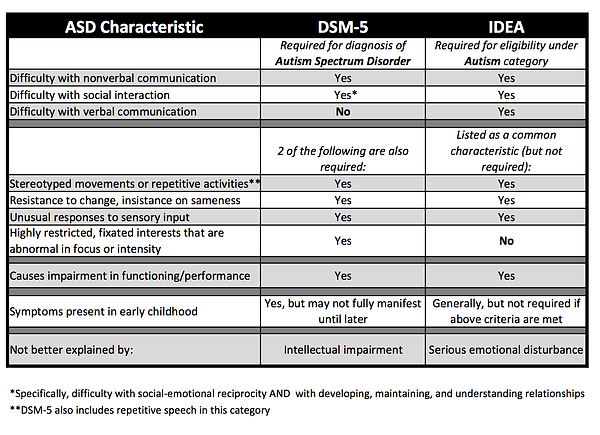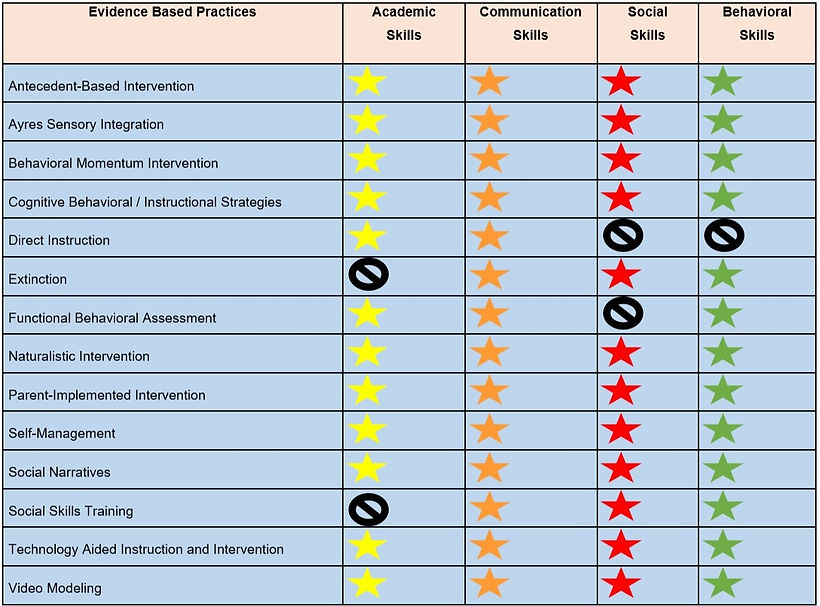
Methods for Learners with
High Functioning Autism Spectrum Disorder

What is High Functioning Autism Spectrum Disorder (HFA)?
High-Functioning Autism is not a “formal” diagnosis. In 2013 a significant change was observed in the framework of autism. The fifth edition of the Diagnostic and Statistical Manual of Mental Disorders combined the former diagnostic categories of Autistic Disorder, Asperger Syndrome, Pervasive Developmental Disorder Not Otherwise Specified and Childhood Disintegrative Disorder into a single diagnostic category of Autism Spectrum Disorder (ASD). The term HFA is often used to refer to individuals diagnosed with ASD who have at least average IQ scores (IQ >70), individuals who previously would have been diagnosed as having Asperger Syndrome.
Why is the difference between DSM vs IDEA definition of ASD significant for learners with HFA?
DSM
The Diagnostic and Statistical Manual of Mental Disorders (DSM) is used by clinicians to diagnose psychiatric illnesses. It provides the clinical diagnosis of Autism Spectrum Disorder.
IDEA
The Individuals with disabilities Education Act provides the administrative diagnosis of autism determining eligibility for special services in USA.

The IDEA requires a learner to have difficulty in verbal communication to be eligible for services under the Autism category. It also requires that the symptoms must not be better explained by serious emotional disturbance. Because of these eligibility requirements a learner with HFA might not receive special services under the Autism category of IDEA. If found eligible under some other category the learners IEP (Individualized Education Program) will not be based on EBPs (Evidence Based Practices) for teaching individuals with ASD.
What characteristics are seen in learners with HFA?
Learners with HFA display a wide range of deficits in communication, behavior regulation, motor skills, academics and social interaction.
Speech
-
Speech delay
-
Vocal pitch and volume differences
-
Echolalia
-
Missing or skipping words
-
Self-interest and off topic speech
-
Difficulty with initiating and carrying on a conversation
Gross motor
-
Tends to be clumsy
-
Difficulty with competitive sports
Behavior
-
Refuses to change activities
-
Temper tantrums
-
Aggressive
-
Overly emotional
-
Wanders away
-
Refuses to listen
-
Hides
Fine motor
-
Difficulty writing (dysgraphia)
-
Difficulty in tying shoes
-
Struggles with working zippers and buttons
-
Difficulty in getting dressed quickly
Social
-
Says inappropriate and embarrasing things
-
Appears mean or rude, inattentive or silly
-
Difficulty in understanding nonverbal communication
Academics
-
Good with numbers, patterns, sequences and puzzles
-
Early decoding reading skills but struggles with reading comprehension
-
Difficulty in understanding abstract concepts
What Evidence Based Practices (EBPs) can be used to teach learners with HFA?
The 28 current EBPs
The NCAEP (National Clearinghouse on Autism Evidence and Practice) team reviewed articles published from 1990-2017 and published their findings in 2020. They characterized 28 practices as EBPs for children, youth and young adults with autism. Learners with HFA also benefit from these same EBPs.
Click the button to view the summary of the findings of the NCAEP team:
Want to learn about some useful EBPs?
Behavioral Momentum Intervention (BMI)
Learners with autism find transitioning between activities hard and tend to resist less preferred or new tasks. BMI is a fast paced teaching sequence utilizing mastered and new/target skills to build a pattern of correct responding. A series of easy requests is followed by a difficult request which is supported by prompting. The quick pace of teaching and positive reinforcement encourages the learner to remain on task and learn new skills.
Social Narratives (SN)
Social Narratives (SN) are used to explain social situations and appropriate behaviors to individuals with ASD. Social Narratives are individualized and written from the perspective of the learner.
What skills can be taught via different EBPs?

(Data compiled from NCAEP 2020 report)
What is Mind-Blindness and Theory of Mind?
"The ability to ascribe thoughts to others, thoughts that might differ from our own, is a sophisticated cognitive skill, known as theory of mind."
Sy Montgomery
Many learners with HFA experience difficulties in understanding the perspective of someone else. Learners with HFA might believe that everyone shares the same opinions, beliefs and interests as they do. This mind blindness or deficits in theory of mind is one of the reasons learners with HFA experience social isolation and social ridicule.
Want to find out more about ASD?
To learn more about Autism Spectrum Disorder click the page buttons:
-
ASD Intro : Introduction to Autism Spectrum Disorder
-
ASD Methods : Education of Children and Youth with Autism Spectrum Disorder
-
ASD Assessments: Application of Assessment Information for Children & Youth with Autism Spectrum Disorder
-
HFA : Methods for Learners with High Functioning Autism Spectrum Disorder
-
Resources: Resources for parents, family members, doctors, paraprofessionals and educators
-
References: References of the information provided in this website